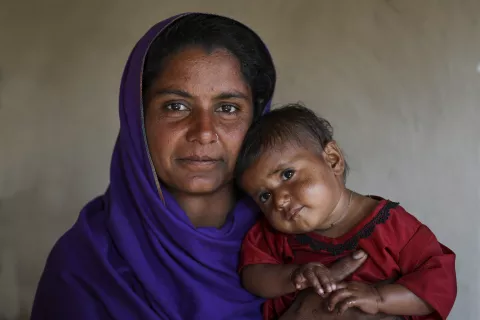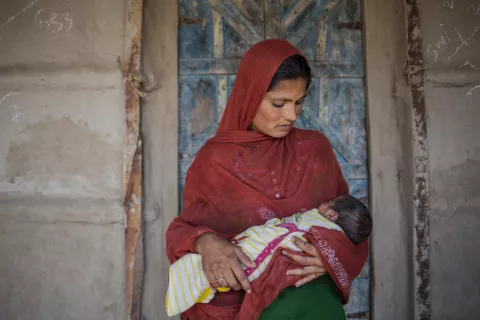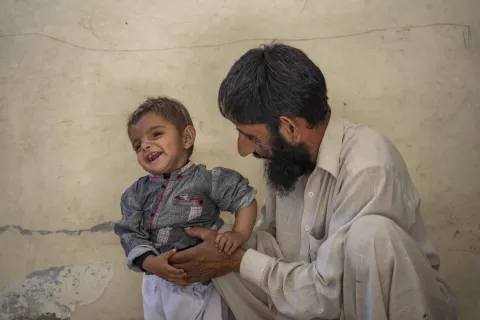Fewer children dying before turning five in Southern Asia than ever before – UNICEF
From 1990 to 2022, the under-five child mortality rate declined by 72 per cent in Southern Asia, a new UNICEF report says.
KATHMANDU/ NEW DELHI, 13 March 2024 – The number of children dying under five years of age declined by two thirds over the past two decades in Southern Asia, according to new mortality estimates released by UNICEF, the World Health Organization (WHO), the United Nations Population Division and the World Bank Group. Southern Asia includes nine countries: Afghanistan, Bangladesh, Bhutan, India, Iran, Maldives, Nepal, Pakistan, and Sri Lanka.
The report reveals that the number of child deaths under 5 years of age decreased from 5 million in 1990 to 1.3 million in 2022. The report also shows that Southern Asia’s under five mortality rate, or the probability that a child would die before five years of age, reduced by 72 per cent since 1990, and 62 per cent since 2000.
“We have made heartening progress to save millions of children’s lives since 1990. These aren’t just numbers on a page – these are children’s lives saved, sons and daughters, brothers and sisters. This success is largely due to investments in trained health workers, improvements in newborn care, treatment of childhood illnesses and vaccinations for children against deadly diseases,” said Sanjay Wijesekera, UNICEF Regional Director for Southern Asia. “This progress shows us that change is possible. These lives saved are testament to the engagement and will of governments, local organizations, health care professionals such as skilled birth attendants, parents, and families to save the most vulnerable children.”
Despite this progress, however, much more needs to be done. An estimated 1 in 29 children under five years of age are still dying in Southern Asia. This is the second largest burden globally after sub–Saharan Africa. One in four under-five deaths in Southern Asia is due to prematurity. Most children under five years of age die due to preventable or treatable causes such as complications during birth, pneumonia, diarrhea, neonatal sepsis, and malaria.
For children everywhere, the riskiest period of life is the first month. In 2022, Southern Asia accounted for 34 per cent of global neonatal deaths, which means that 1 in 3 newborn babies dying globally was from the region. In fact, the share of newborn deaths to under five deaths increased from 46 per cent in 1990 to 63 per cent in 2022, underscoring the need for greater investment in saving newborns.
The report also reveals that progress among countries is uneven. Three countries (Iran, Sri Lanka and Maldives) have achieved the SDG 2030 target for under five child mortality reduction and four are on track to meet the target (India, Bangladesh, Bhutan and Nepal). For example, Bangladesh’s neonatal mortality rate decreased from 66 deaths per 1,000 live births in 1990, to 17 deaths per 1,000 live births in 2022.
However, in Pakistan and Afghanistan, urgent action is required to accelerate their annual rates of reduction substantially to meet 2030 targets.
Without urgent action to save lives, an estimated eight million children under five will die from now until 2030 in Southern Asia – more than half of them newborns. Disparity and inequity are still driving deaths of children across the region.
“Millions of babies are still dying in Southern Asia because of who they are and where they are born,” added Wijesekera. “We call on governments across the region to invest in simple solutions such as having trained birth attendants at every birth, ensuring that all newborns have essential care, better care of small and sick newborn babies, medicines, clean water, electricity, and vaccines to save lives. Every child has the right to healthcare.”
###
Notes to editors
Download photos and broll from South Asia here. For regional and country data and to browse the report, click here.
About UN IGME
The United Nations Inter-agency Group for Child Mortality Estimation or UN IGME was formed in 2004 to share data on child mortality, harmonise estimates within the United Nations system, improve methods for child mortality estimation, report on progress towards child survival goals and enhance country capacity to produce timely and properly assessed estimates of child mortality. UN IGME is led by UNICEF and includes the World Health Organization, the World Bank Group and the United Nations Population Division of the Department of Economic and Social Affairs. For more information visit: http://www.childmortality.org/
About UNICEF in Southern Asia
UNICEF works in some of the world's toughest places, to reach the world's most disadvantaged children. Across more than 190 countries and territories, we work for every child, everywhere, to build a better world for everyone. For more information about UNICEF’s work for children in Southern Asia, visit www.unicef.org/rosa. Follow UNICEF on Twitter and Facebook.
Media contacts
About UNICEF
UNICEF promotes the rights and wellbeing of every child, in everything we do. Together with our partners, we work in 190 countries and territories to translate that commitment into practical action, focusing special effort on reaching the most vulnerable and excluded children, to the benefit of all children, everywhere.
For more information about UNICEF and its work for children, visit www.unicef.org




